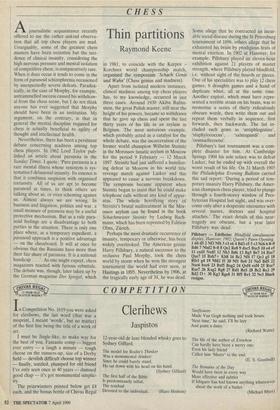CHESS
Thin partitions
Raymond Keene
Ajournalistic acquaintance recently offered to me the rather unkind observa- tion that all top chess players are mad. Unarguably, some of the greatest chess masters have been eccentric but the inci- dence of clinical insanity, considering the high nervous pressure and mental isolation of competitive chess, is comparatively rare. When it does occur it tends to come in the form of paranoid schizophrenia occasioned by unexpectedly severe defeats. Paradox- ically, in the case of Morphy, for example, untrammelled success caused his withdraw- al from the chess scene, but I do not think anyone has ever suggested that Morphy should have been in an institution. My argument, on the contrary, is that in general the mental discipline required for chess is actually beneficial to agility of thought and intellectual health.
Nevertheless, there has been a persistent debate concerning madness among top chess players. In 1962 Lord Taylor pub- lished an article about paranoia in the Sunday Times. I quote: 'Pure paranoia is a rare mental illness whose synonym is sys- tematised delusional insanity. Its essence is that it combines suspicion with organised tortuosity. All of us are apt to become paranoid at times, to think others are talking about us, or even scheming against us. Almost always we are wrong. In business and litigation, politics and war, a small measure of paranoia may be a useful protective mechanism. But as a rule para- noid feelings are a disadvantage to both parties in the situation. There is only one place where, as a temporary expedient, a paranoid approach is a positive advantage — on the chessboard. It will at once be obvious that the Russians have more than their fair share of paranoia. It is a national handicap . . .'. As one might expect, chess magazines reacted with furious rebuttals. The debate was, though, later taken up by the German magazine Der Spiegel, which in 1981, to coincide with the Karpov – Korchnoi world championship match, organised the symposium `Schack Genie and Wahn' (Chess genius and madness).
Apart from isolated modern instances, clinical madness among top chess players has, to my knowledge, occurred in just three cases. Around 1930 Akiba Rubin- stein, the great Polish master, still near the height of his powers, became so withdrawn that he gave up chess and spent the last thirty years of his life in an asylum in Belgium. The most notorious example, which probably acted as a catalyst for the whole debate, was the incarceration of the former world champion Wilhelm Steinitz in the Morossov lunatic asylum in Moscow for the period 9 February — 12 March 1897. Steinitz had just suffered a humiliat- ing defeat in Moscow in his world title revenge match against Lasker and this appeared to cause a nervous breakdown. The symptoms became apparent when Steinitz began to insist that he could make telephone calls without any kind of appar- atus. The whole horrifying story of Steinitz's brutal maltreatment in the Mor- ossov asylum can be found in the book Schachmeister Steinitz by Ludwig Bach- mann, which has been reprinted by Edition Olms, Zurich.
Perhaps the most dramatic occurrence of insanity, temporary or otherwise, has been widely overlooked. The American genius Harry Pillsbury, a natural successor to the reclusive Paul Morphy, took the chess world by storm when he won the strongest tournament the world had ever seen, at Hastings in 1895. Nevertheless by 1906, at the tragically early age of 34, he was dead. Some allege that he contracted an incur- able social disease during the St Petersburg tournament of 1896, others allege that he exhausted his brain by prodigious feats of mental exertion. In 1902 at Hanover, for example, Pillsbury played an eleven-hour exhibition against 21 players of master strength, where Pillsbury played blindfold, i.e. without sight of the boards or pieces. One of his specialities was to play 12 chess games, 6 draughts games and a hand of duplicate whist, all at the same time.
Another exploit, which must have repre- sented a terrible strain on his brain, was to memorise a series of thirty ridiculously obscure words, then write them out and repeat them verbally in sequence, first forwards, then backwards. The list in- cluded such gems as 'antiphlogistine', `staphylococcus', 'salmagundi' and `oomisellecootsi'.
Pillsbury's last tournament was a com- plete disaster for him. At Cambridge Springs 1904 his sole solace was to defeat Lasker, but he ended up with overall the worst result of his life. On 31 March 1905
the Philadelphia Evening Bulletin carried this sad report: 'During a period of tem- porary insanity Harry Pillsbury, the Amer-
ican champion chess player, tried to plunge through a fourth-storey window of Pres- byterian Hospital last night, and was over- come only after a desperate encounter with several nurses, doctors and hospital attaches.' The exact details of this near- tragedy are obscure, but a year later Pillsbury was dead.
Pillsbury — Edelheim: Blindfold simultaneous display, Hanover, 1902; Queen's Pawn Opening. 1 d4 d5 2 N13 Nf6 3 e3 e6 4 Bd3 c5 5 c3 Nc6 6 0-0 Bd6 7 Nbd2 0-0 8 Qe2 Re8 9 dxc5 BxcS 10 e4 e5 11 exd5 NxdS 12 Nb3 Bd6 13 Bg5 Be7 14 Bxe7 Qxe7 15 Bxh7+ Kh8 16 Bc2 Nf4 17 Qe3 g5 18 Rfel g4 19 Nfd2 f5 20 Nn Be6 21 Na5 Bd5 22 Nxc6 bxc6 23 BxfS Bxg2 24 Qxf4 exf4 25 Rxe7 Rxe7 26 Kxg2 Rg8 27 Rdl Re5 28 Bc2 Re2 29 Rd2 /3+ 30 Kg3 Rge8 31 Bf5 Rel 32 Ne3 Black resigns.


























































 Previous page
Previous page